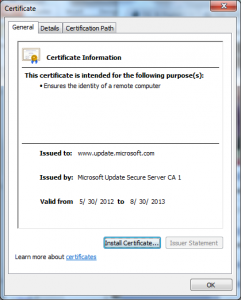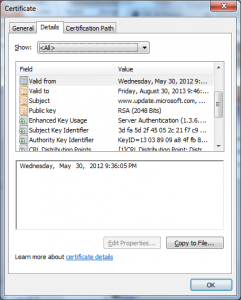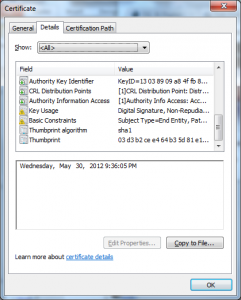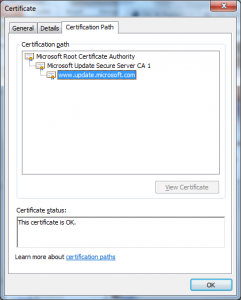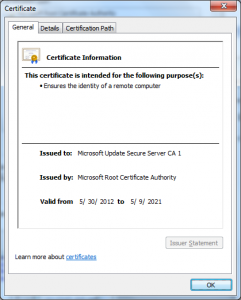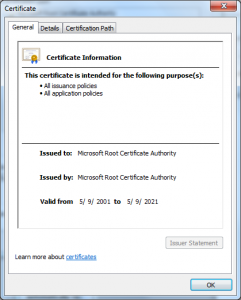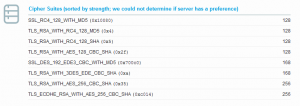Today about 80% of all SSL certificates on the Internet that are in use are what are commonly referred to at Domain Validated (DV) certificates. The name is a bit of a misnomer in that not all DV certificates authenticate control of a Domain in-fact most actually authenticate the control of a specific server in the domain.
The large majority of these certificates can be issued with little to no human interaction. In a typical manual enrollment a server administrator generates and submits a certificate request and in return is provided a random value that they are instructed to place into a HTML meta-tag in /index.html that the CA will check for periodically to see if administrator was able to place it there. The idea being that modifying a the meta-tag there is sufficient to prove control over the website. Once the CA notices the administrator was able to complete this task it performs a handful of other checks and the certificate is issued.
Most certificates used for SSL end up coming from hosting providers, service providers and certificate resellers that sell these certificates for as little as a few dollars and in many cases they simply give them away for free.
These folks will also commonly automate the issuance, installation and maintenance of these certificates. Hosting providers typically do this using a plugin that comes from the issuing CA that hooks into their management console (WHM, etc) and the larger more advanced ones write their own based on the web services exposed by the certificate authorities.
So today, contrary to common perception certificates are in-fact are cheap to free and in many cases fully automated. With that said there are a number of pretty important cases where that automation is missing such as cloud service providers (AWS, Azure, Google Cloud, Rackspace, etc), corporate servers and Internet connected devices.
At some point all of the cloud service providers will provide SSL for free after all Mozilla has recently stated that they are working to deprecate HTTP all together and I am sure all other browsers will follow them when there is sufficient SSL ubiquity.
The Let’s Encrypt project aims to make this transition happen faster by being yet another place to get free certificates and making the acquisition of these certificates even easier by closely integrating the certificate lifecycle management into the most commonly used servers.
It is this last part that I think is the most important contribution that Let’s Encrypt will make to the Internet. There are a few reasons for this; for various reasons I could go on about for hours each of the Certificate Authorities have gone and created their own protocols for certificate enrollment instead of working together to define a common one. These protocols (like their cousins from device and operating system vendors) are designed around their specific back-ends and not generic enough to be used when they are not the entity behind them.
To address this the the Let’s Encrypt people have proposed a new modern REST based protocol that does not have this baggage. In fairness it also doesn’t solve all of the CAs needs either but I can easily envision how one would extend it to do so (in-fact it looks a lot like a protocol I designed for GlobalSign’s use).
The other problem not many actually understand is how many issues exist inside the various SSL implementations that prevent a third-party from properly automating the lifecycle of a certificate without downtime. The simplest example being for a external program to change certificates on a running web server it often has to rely on HUPing a the server to force it to pick up the new certificate.
Unfortunately Certificate Authorities are not exactly the most loved people on the Internet and I know from my experience trying to get the maintainers of web servers and SSL stacks to support things like OCSP Stapling that the scale of changes that are necessary to make automated certificate lifecycle totally seamless (and with low risk) for everyone was unlikely going to happen when driven by CAs.
NOTE: In my opinion a big reason for the resistance is that CAs have basically treated these projects as core infrastructure without supporting them financially or by hiring developers to contribute to them. That said this has been slowly changing and despite that the “love” still continues.
The Let’s Encrypt project is a project for developers by developers with the skill, credibility and motivation to fix these issues.
When they are successful (and I am confident they will be) those solutions that use the clients based on their code and protocol will rarely if ever experience an outage due to an expired certificate. Notice I didn’t say the clients that use Let’s Encrypt ? Thats because what they are doing is solving the plumbing problem that CAs have failed to solve and the CAs will be able to benefit from this work also.
It will also enable a class of products and services that otherwise would not have the technical experience, financial means or motivation to otherwise integrate SSL into their product.
Imagine your next refrigerator having a web portal you could log into at https://myhome.refrigerators.com where you could check if you needed to bring home milk where the portal was protected with SSL. These and other projects are unlikely to happen without something like Let’s Encrypt.
So when people tell me “Certificates are already practically free why do we need Let’s Encrypt?” I tell them they need to look at the long game.

